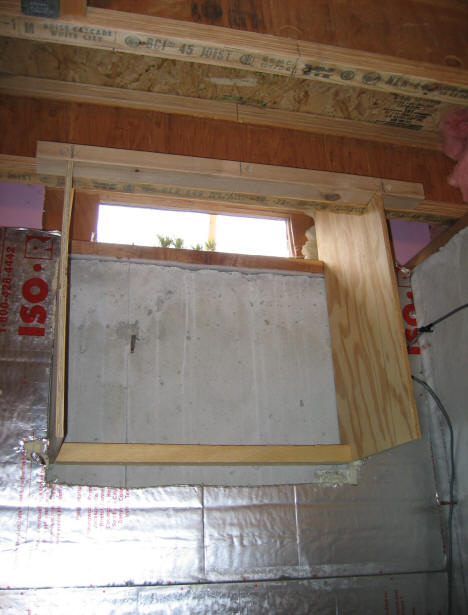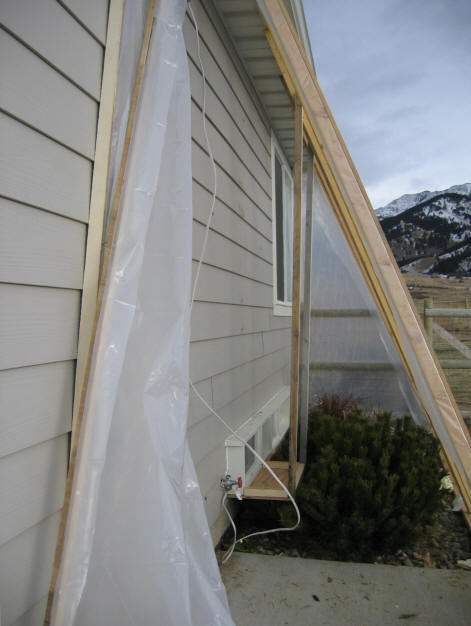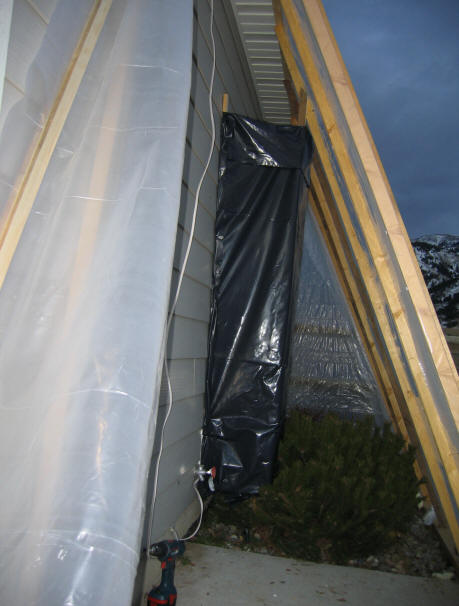
Search
The Renewable Energy site for Do-It-Yourselfers
A Crude, Mini,
Poly Sunspace Heater
|
This was something I put together as
a kind of experiment to see if a little sunspace made from scrap lumber and some
poly sheeting could collect any useful heat.
It is against the only bit of south
wall that we have -- maybe 12 ft in all.
The frame is made from some left over
lumber, and just slopes down from the roof eave to the ground.
It is covered with clear
polyethylene.

The "absorber" is some left over
black poly sheeting.
|
|
This simple sunspace heats the crawl
space under the master bedroom. This crawl space was previously converted
to a "conditioned" crawl space by closing all the vents, sealing a poly vapor
barrier down over the dirt floor, and insulating the walls with rigid foam
insulation. By heating the crawl space, the bedroom floor above is warmed,
and radiates heat into the bedroom.
The air from the crawl space enters
the sunspace heater on the east end through a vent cut in the rim joist.
The hot air is collected from the top of the sunspace heater by a duct (made
from poly sheeting!) that goes through another vent cut in the west end of the
rim joist.
An attic fan (the only thing I
purchased for this project) is mounted in the crawl space to pull air down the
duct from the top of the sunspace, through the rim joist, and blows it out into
the crawl space. The fan is turned on by the thermal snap switch that came
with the attic fan. The thermal snap switch is mounted at the top of the
sunspace.
When it gets to around 85 F, the fan
is turned on, and pulls hot air from the top of the sunspace down and and blows
it into the crawl space.
The whole thing is a bit crudely built,
and the flow path is a bit awkward. But, it works. The
sunspace heated up. The fan was able to pull air from the top of sunspace
and blow it into the crawl space, and the bedroom was noticeably warmer.
We only used this for one winter,
because the plan was to replace it with a "real" sunspace (still on the "to-do"
list).
It actually held up well to our tough
winter, including some good wind storms.
The only damage it suffered was when
our neighbors dog would occasionally make a door in the poly in order to get tot
he nice warm space inside :)
It shows how easily, quickly, and
inexpensively a solar heater that provides significant heating can be done.

Before

The framework. The bottom plate
2X4 is just nailed to the ground using some 12 inch long steel spikes.

12 inch spikes holding bottom plate to ground.

Most of the poly in place. The poly was tacked in place over the frame,
then half inch thick battens were tacked over the poly, capturing it between the
frame and the batten. I am guessing there are better ways to do this.
The end panel (the part not covered
in this picture) was made removable (studs and wing nuts) to be able to get into
the space.

The inlet vent cut in the outside wall. Leads to the crawl space under
bedroom.

View from inside the crawl space
showing the vent to outside, and the framing that the attic fan will be attached
to.

The attic fan in place in the crawl
space. This attic fan is probably not ideal for this application, but it
was cheap, and it came with a thermal snap switch control, which was needed to
turn it on when the sunspace go hot enough.
Note that there is another vent from
the crawl space to the sunspace that allows air to return to the sunspace.

The competed outer envelope (the
black poly "absorber" has not been added as yet).

This shows the framework for the
"duct" that takes air from the top of the sunspace and delivers it to the crawl
space vent. The black poly that makes the duct walls is just stapled to
this framework.

This is the finished hot air "duct".
Elegant huh!
After this was done, I added 1) some
left over Reflectix insulation over the floor of the sunspace (to keep it from
absorbing sunlight), and 2) more black poly stretching from east to west on
either side of the hot air duct, such that all of the sun shining through the
clear poly would be absorbed by the black poly. The black poly heated up,
which heated the air near it, which would rise to the top of the sunspace,
and be pulled down the hot air duct to the crawl space. I did not get any
pictures of the finished product with all the black poly installed.
I did not make any attempt to measure
the total heat delivered or the efficiency, but on fairly cold sunny days, it
did heat the air at the top of the sunspace up to the point where the fan (which
was set to turn on at 85F) ran most of the day. It delivered what appeared to be
a worth while amount of 85f to 95F air to the crawl space, and the bedroom above
was noticeably warmer.
It is not shown on the pictures, but
there was a poly backdraft damper on the duct that let air from the crawl space
into the sunspace to prevent backflow of cold air from the sunspace into the
crawl space at night -- this is essential to prevent a lot of heat loss at
night.
Gary 11/17/06, Oct 16, 2007
